Matt S.
Besides the fact that it has the greatest title of all time, I was inspired to play this scenario from Armies of Oblivion by Zeb’s excellent After Action Report of his rocking game of against Eric. As our cardboard soldiers duked it out over the course of a couple of gaming sessions, Brian and I discovered Huns of Steel is an interesting, complex scenario with a lot of options for both sides and therefore a lot of replay value. It depicts a Hungarian attack to wipe out a Russian bridgehead on the west side of the Don River in the summer of 1942. The battlefield is modeled with three boards. The closest board from the Hungarian perspective (44) is rather open, while the crossroads village and surrounding large grain fields of board 48 is in the center. The far board (43) is transformed with a new river overlay. It still has its very large grain fields and brushy area, and also the famous walled compound. The Soviets have two pontoon bridges they’ve thrown across the river. One is very close behind the walled village (the compound) just to the left of center, while the other is a little farther to the right. To win the Hungarians have to clear the areas on the near side of each bridge of Good Order Russian units. They have a rather formidable force to do the job: twelve elite squads of cavalry, eight squads on motorcycles, and a variety of tanks, many of them German-made. The Russian defense has 14 rifle squads and four conscript squads, a variety of support weapons (most notably a few antitank rifles, and heavy and medium machine guns), some wire, a couple of roadblocks, and a 76L artillery piece. They get reinforced first by some lend-lease Stuart and Valentine tanks, and later by a trio of T34-M41s.
I wanted to try the Hungarians, and Brian, ever the sportsman, accepted and took the Russians. At first glance the defense appeared to have some units deployed forward to offer some resistance in the crossroads village, with the bulk of the forces farther back in the compound area, and just a couple at the farther pontoon bridge. There was no telling where the wire, roadblocks, or the gun were. I suspected that several of the forward units were dummy stacks of course. I briefly considered wide flanking maneuvers but decided instead to try to blitz the crossroads village as quickly as possible and try to eliminate the Russians that were there before they could retreat to better defense lines around the bridges. The crossroads village of board 48 is notoriously difficult to defend, and for a brief time before his armored reinforcements arrived, I expected to be able to use the mobility of my forces, particularly the Toldis and LTvz38(t)Es, to surround and overwhelm any defenders there. The first turn was rather uneventful as my motorcyclists and cavalry rushed to the village supported by the lighter tanks. The more valuable PzIVF2s with their potent 75L guns and smoke ammunition capability, I held back at long range to avoid losing them to the hidden Russian gun or some other mishap. Instead they were to acquire targets for smoke rounds on turn 2. With a mild breeze blowing in this scenario, the smoke would drift, making it possible for the Hungarians to really lay down some effective smoke screens. The Hungarian troops quickly discovered that the approaches to the village were covered with wire, which proved problematic for the attack. Avoiding the wire really slowed it down, particularly the tanks.
Positions after turn 1:
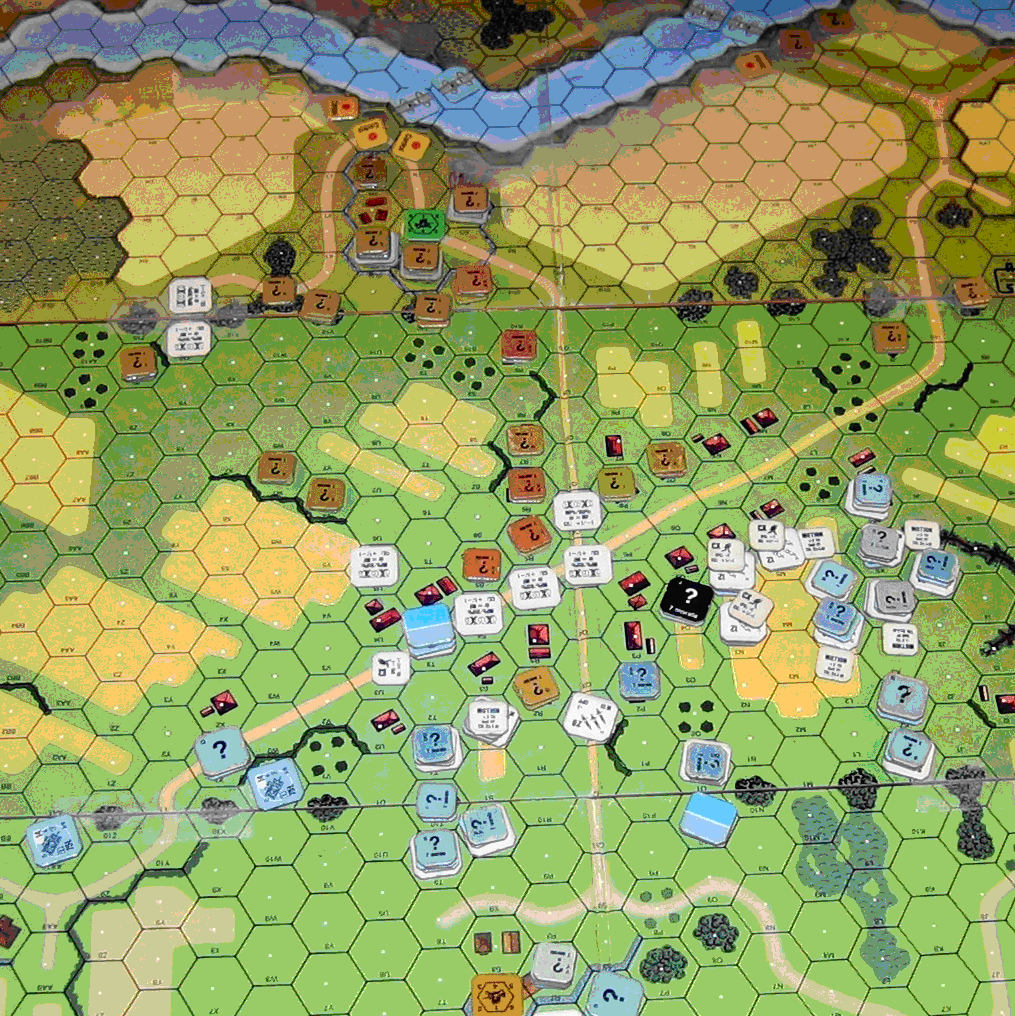
The Russian half of turn 1 was uneventful as they mostly skulked and tried to retain concealment. On turn 2 the tanks placed a few smoke rounds in key positions and then the Huns pressed the assault hard on the village. The artillery piece was revealed since it was not in concealment terrain. Rather it was in the compound, behind a roadblock that was placed to cover the gap in the wall. Soon the wind would carry drifting smoke over it and in front of it, but time still seemed precious. The Stuarts and Valentines would arrive in the Russian half of the turn, and they were superior to the Toldis and the LTvz38s. So a Toldi ventured forth on an infantry suppression task in the village, chancing a passage in front of the gun, when its luck ran out and a 76mm shell wrecked it.
Positions after Hungarian turn 2:
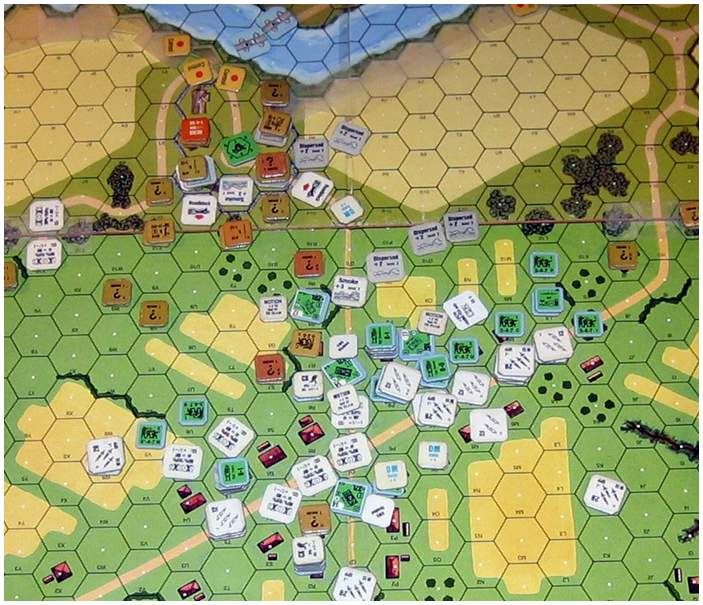
In their half of turn 2, the Russians again skulked and took potshots here and there. One of the thin-skinned Toldis was dangerously close to an ATR near the compound. The Soviet tank reinforcements split up. Three went to the left of the compound and took up good blocking positions. The other three went to the right of the compound, with two Stuarts in the large field of grain in the middle, and the Valentine off to the right behind a hedge. I thought this was a very good play by Brian and was quite worried about how to engage his tanks. The two Valentines with 6 armor factors all around, and 8 on the front turret, would be tough to knock out with anything smaller than a PzIVF2’s 75L gun. The four Stuarts were perhaps not quite as tough with armor factors of 4 and boxed 3 front and side, but both the Stuarts and the Valentines had guns that commanded respect on this battlefield. The 37LL and the 40L have basic kill numbers of 11 and 10 respectively, which is plenty when dealing with the sardine-can Toldis with their armor factor of circled 2 and 1. The LTvz38s are almost as good as the Stuarts, with 4 armor factors on the front and a 37L gun of their own with a basic kill number of 9. Even the PzIVs, the best tanks on this battlefield, could not take it for granted in a straight-up fight with the Stuarts and Valentines. Most troubling to me was that my Hungarian tanks were mostly tied up in the village and not in the best position to engage the Russian tanks. I was not eager to use the PzIVs either, if it meant giving the Russians the first couple of good shots. Fortunately one of the Stuarts in the center grain area malfunctioned its gun on its first shot. This left his partner rather isolated momentarily. Although the artillery piece was nearby, it was enshrouded in smoke and therefore much less likely to hit anything.
Positions after Russian turn 2:
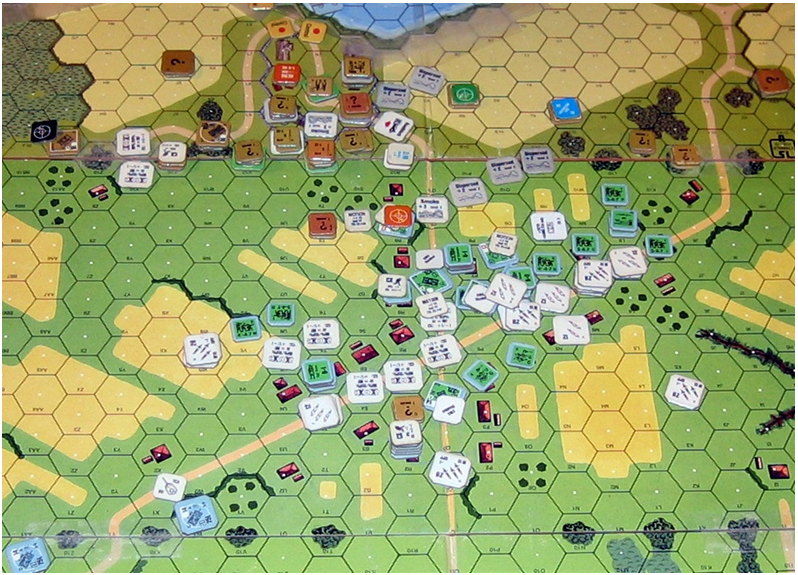
A Stuart malfunctions its main gun at a bad time (is there ever a good time?):
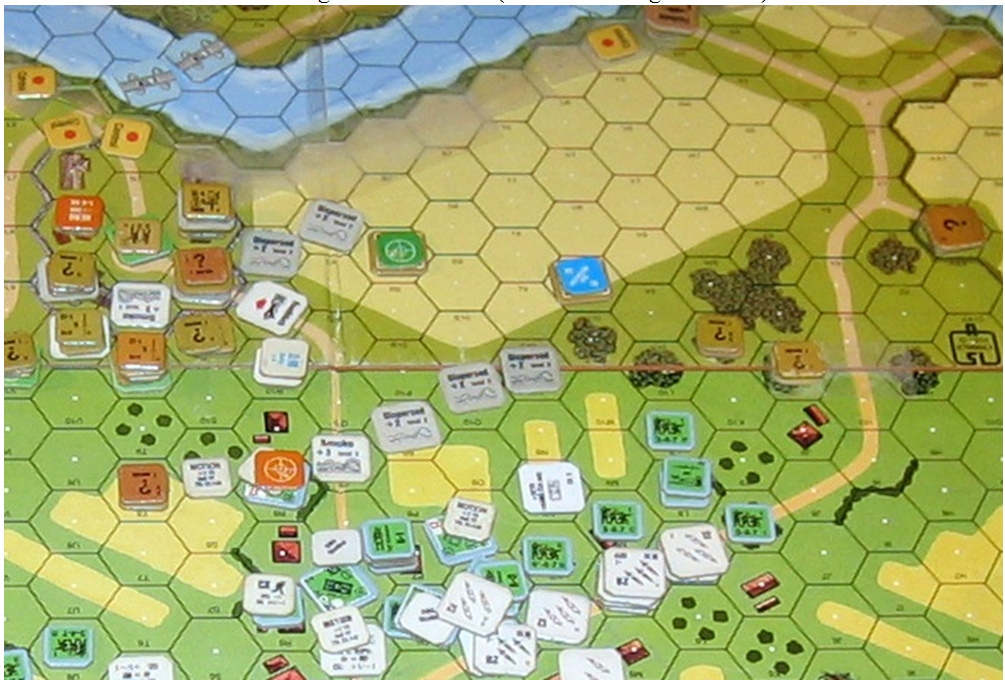
Things really got interesting in turn 3. The Hungarians had successfully cleared the outlying village. There weren’t that many Russians there in the first place, just a few conscripts and some dummies. A few Russians were in the woods on the approaches to the right pontoon bridge, and a couple of conscript squads had managed to retreat toward the walled compound. A couple of other conscripts were eliminated. A few Hungarian troops were broken, but by now they had all dismounted and were in fairly good shape, although there wasn’t a lot of cover now between them and their attack objectives. Moving through such terrain under fire is difficult. The Russian tanks had taken up good blocking positions. However the malfunctioned gun of the Stuart in the center appeared to offer an opportunity and the Hungarians tried to seize the moment. One of the LTvz38s actually managed to hit the lead Stuart with an APCR shot, but failed to penetrate. Not wanting to trade shots frontally with superior tanks, the Hungarians pressed the attack. A Toldi raced forward, outside of the covered arc of the leading Stuart. The Toldi got behind the Stuart and stopped and popped the hatch to go crew exposed, hoping to get a shot through its rear armor where it had its best chance to penetrate if it could get a hit (still not great though: basic kill number of 6 for a 20L, up by 2 for the short range to 8, up by another one for a rear shot to 9, minus 3 for the armor of the Stuart yields a 6, still less than a 50% chance). The medium machine gun in the compound took a shot to try to penetrate the thin armor of the Hungarian tank, but failed. The Stuart didn’t like the odds so it kicked into motion to make it harder to hit, and turned its frontal armor to the Toldi. With no realistic hope of knocking that Stuart out now, the Toldi still had plenty of movement left, so it started back up and got behind the other Stuart, the one with the malfunctioned gun, and stopped to line up shot. This Stuart decided to hold its ground, but it paid the price. A bounding fire shot from the Toldi killed it.
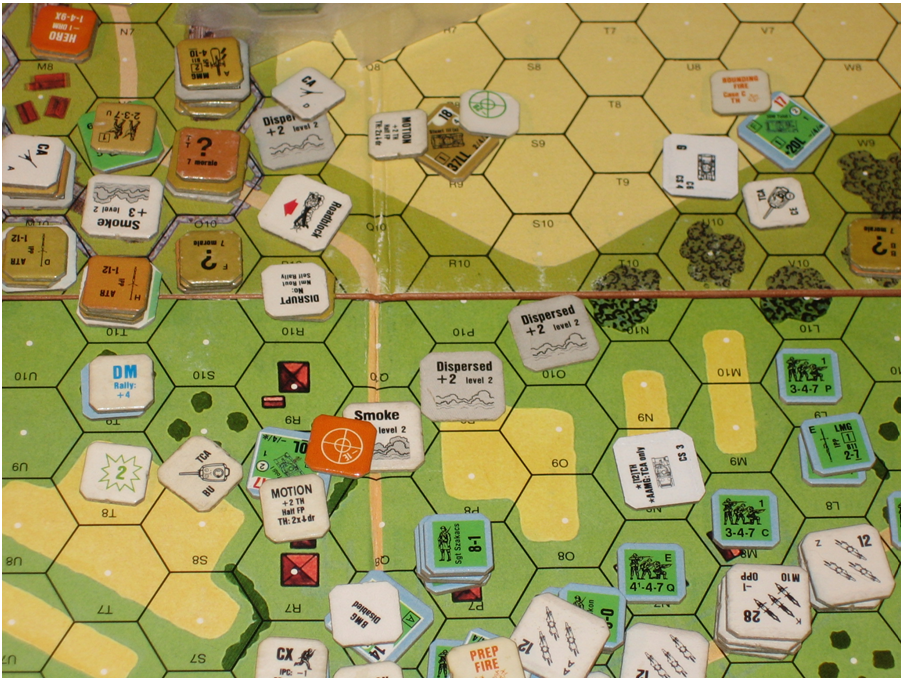
Now the central area was more open. The motion Stuart that was left was vulnerable and certainly not likely to hit anything while in motion, but swarming it still did not seem like a good idea, because that would leave the Hungarian tanks out in the middle grain in range of the big artillery piece in the compound. The smoke on that piece would clear very soon and then it would be truly dangerous indeed. So instead the remaining Hungarian tanks pushed to the right flank with the dual purpose of supporting the straight-shootin’ Toldi, and of suppressing the Russian infantry in the woods there to help leverage the infantry assault on the right flank. So the Hungarians were now attacking in two directions from the village. About six or seven squads, supported by a few tanks, attacked toward the small copse of woods on the road to the right-side pontoon bridge, while the other Hungarian infantry pushed forward and to the left to try to get close to the compound. One of the highlights during this time was how the infantry came to the rescue of one of the Toldis. It was in motion just 3 hexes away from an antitank rifle that had a good chance of knocking it out. The infantry, despite a paltry smoke exponent of 1, managed to place two smoke grenades on the Toldi to make it harder to hit, and it escaped to go support the other tanks on the right side. Meanwhile more tank support arrived this turn in the form of two more PzIVF2s with their nice 75L guns, three PzIVF1s with short-barreled 75s but lots of smoke ammo, and a couple of Nimrods. I always thought I’d have to go into management if I wanted to command some Nimrods, but thanks to Armies of Oblivion I can do that when I play ASL instead! J These reinforcing tanks pushed up the left flank to try to support by weight of numbers the assault on the Stuarts and Valentine over there. The PzIVF1s took up positions to try to place valuable smoke cover again on the compound area.
Right flank and center on turn 3:
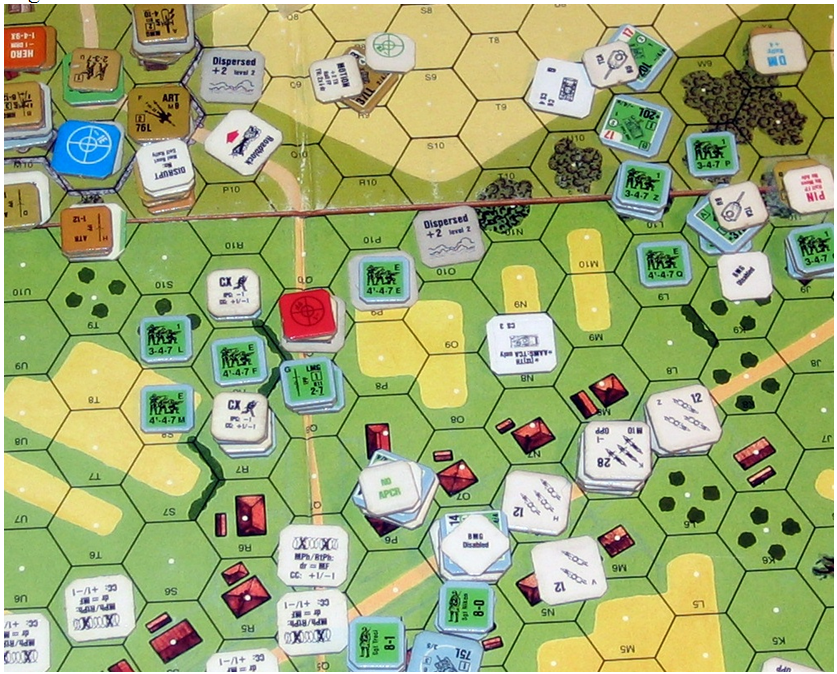
At this point I was rather pleased with the progress of my Hungarians. They had traded a Toldi for a Stuart, cleared the central village, and were in the process of clearing the woods just beyond it as a precursor to assaulting the far pontoon bridge area. In the center the Russians had no armor support anymore, but it still looked like a tough task to attack the walled compound, because there wasn’t that much cover on the way in. Moreover the Russian right flank or Hungarian far left on the other side of the compound had two Stuarts and a Valentine in support in good positions. However, the reinforcing tanks were motoring into the area and gave a large numerical superiority to the Hungarians in that potential tank battle. Still the Russians had been causing some damage themselves. The gun in particular scored some good hits on infantry targets, elimating or breaking a couple of squads, and the medium machine gun too many great shots from its perch at level 1, which allowed it to often see over the grain fields unhindered when there wasn't smoke in the way, and it was sometimes able to catch unwary enemy infantry and break them. Also in his half of turn 3 Brian made some good moves to shore up his position. The Stuart in the center sped over to get revenge on the Toldi that had caused so much grief earlier, and took a bounding fire shot, but missed. So it then restarted and moved into a good blocking position close to the right pontoon bridge. Then the Valentine on that flank started up and moved over behind the Toldi, popped the hatch to go crew exposed, and nailed it with a bounding fire shot of its own. I only had one Toldi left, and it did not want to engage in a firefight with the Valentine because it had almost zero chance of penetrating its armor, so it kicked into motion and pivoted to make good its escape on the next turn. Nearby Hungarian squads in the woods, however, fired on the exposed crew of the Valentine and stunned it. This was a very valuable result as later events would prove. On his other flank, Brian pulled his tanks back to the compound, with two of them gaining hull down positions. It looked like a formidable hedgehog over there indeed, with the Valentine closest to the bridge. You can also see the stunned Valentine and its Toldi victim at the far right of the picture:
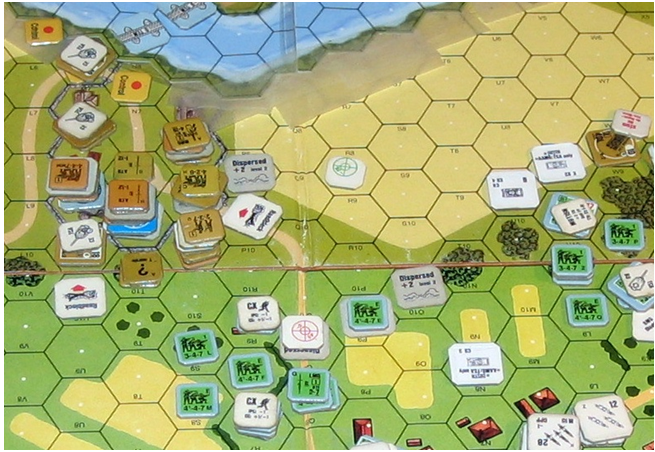
Things got even more exciting in turn 4. The vaunted T-34 M41s were scheduled to arrive in turn 5, and I wanted to have my Panzer IVs ready for them. But there was still the matter of those pesky Stuarts and Valentines to take care of. I didn’t think there was a lot of time to waste. The T34s could drive across the pontoon bridges and park in the victory area as soon as they entered, and they would be difficult to eliminate. Therefore I pressed the attack as hard as I dared on both flanks. First on the right flank the remaining Toldi drove out to try to play the same trick on the Stuart. Since it was my least valuable tank, I thought Brian would be reluctant to shoot at it and it might get lucky again and cause trouble by using up the Stuart’s fire opportunities or getting him to kick into motion or perhaps even get really lucky and knock him out. But it was not to be. Brian wasn’t going to have any of that funny business this time, and as the Toldi came into view to run down the road at his Stuart, the Stuart opened fire and knocked it out easily. At least he used up his rate of fire. A LTvz38 went next, straight at the Stuart, hoping to get behind him or at least get a side shot. But as soon as the LTvz38 got next to the Stuart, it used intensive fire to knock him out. Ouch. Two-zip Rooskies. I sent a second LTvz38 now and the Stuart had no shots available, so it managed to sidle up adjacent and take a bounding fire shot right at the flank, but missed. Egads. The Russians would get to shoot next in their Prep Fire Phase, and they had not only the Stuart but the Valentine over there as well. The Valentine had not yet fired. I still had my heavy-hitter left though, a PzIVF2. It cruised right up to the Stuart and stopped adjacent to line up a pretty good shot, but also missed. Yikes. Now it was looking decidedly ugly for the Huns on this flank. It was very likely that in the next fire phase the Russians would kill both tanks. This flank looked like a goner. The infantry, however, pressed forward and eliminated the last couple of Russian squads in the woods due to failure to rout. The Stuart managed to break a Hungarian squad with its machine guns but otherwise could not save his infantry comrades from their fate.
The right flank on turn 4:
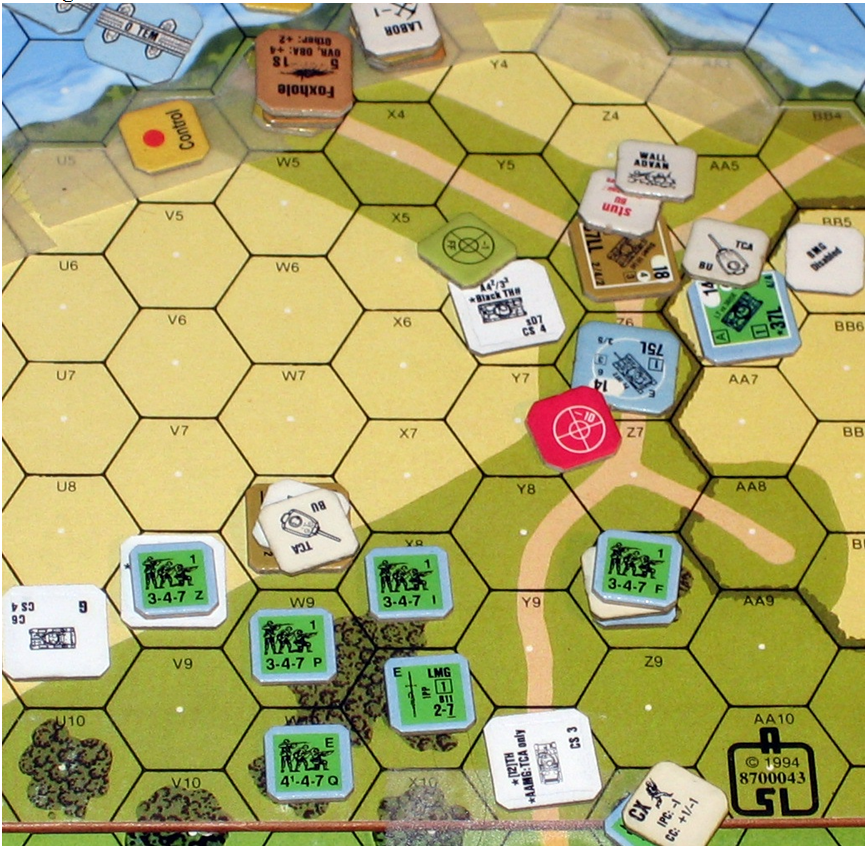
On the left flank in turn 4, things started out well with some good luck in prep fire. Two cavalry half squads had ridden over there early in the game and assembled their light mortars, and had been dropping rounds on the Soviets in the woods in front of the compound as much as possible, with little effect. However on this turn, two consecutive critical hits from one of the light mortars eliminated a Russian squad in the woods on that flank. Then the tanks pushed forward as hard as they could. Most of them didn’t have enough speed to get far enough to properly swarm the defending armor, but one Panzer IVF2 risked it and drove into the woods angling for a side shot at the closest Stuart which was behind the roadblock. Both Stuarts fired at the Hungarian tank but missed, and the Panzer IV missed his bounding fire shot too. But another tank, a PzIVF1, then drove right up to the roadblock to try to nab the Stuart. It tried for AP ammo but didn’t have any, so it was forced to try HE instead. One critical hit later, scratch another Stuart. None of the other tanks were able to hit anything, but they were getting closer and closer, and soon would be able to bring their full weight of numbers to bear on the beleaguered defenders of the compound. In a rare occurrence, the wind had shifted direction at the beginning of this turn, which would cause smoke to drift toward the upper left rather than the upper right. Hence a smoke round in the compound helped cover the assault at just the right moment.
The left flank on turn 4:
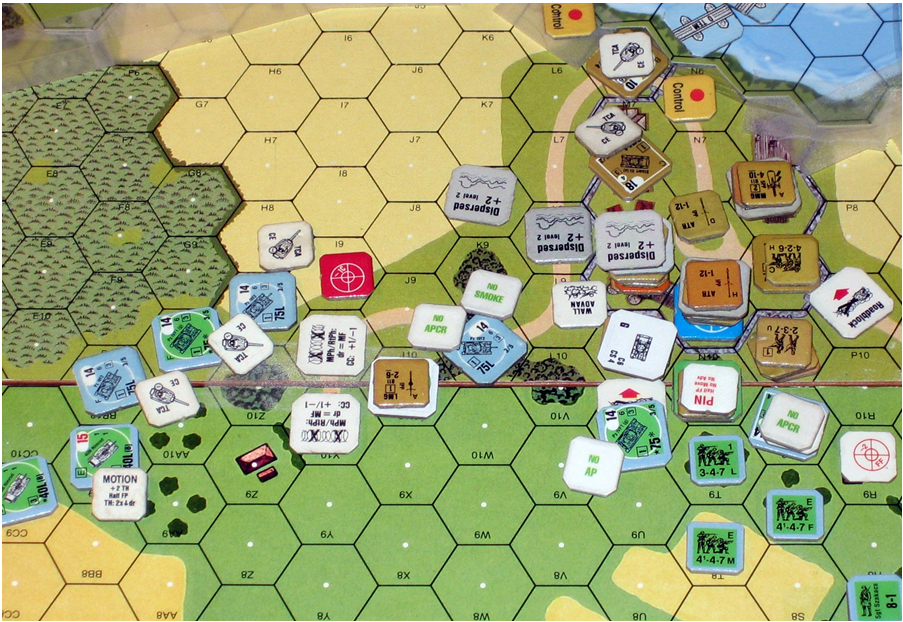
In the Russian half of turn 4 on the left flank, the remaining Stuart traded shots with the Panzer IVF2 in the woods, with the Stuart coming out the loser, as the hard-hitting 75L turned it into a burning wreck, creating yet more drifting smoke on this flank. The Valentine scootched back a little bit to get within the compound and behind the wall. One of the Hungarian medium machine guns finally got into the battle and some well-directed fire broke a Russian squad.
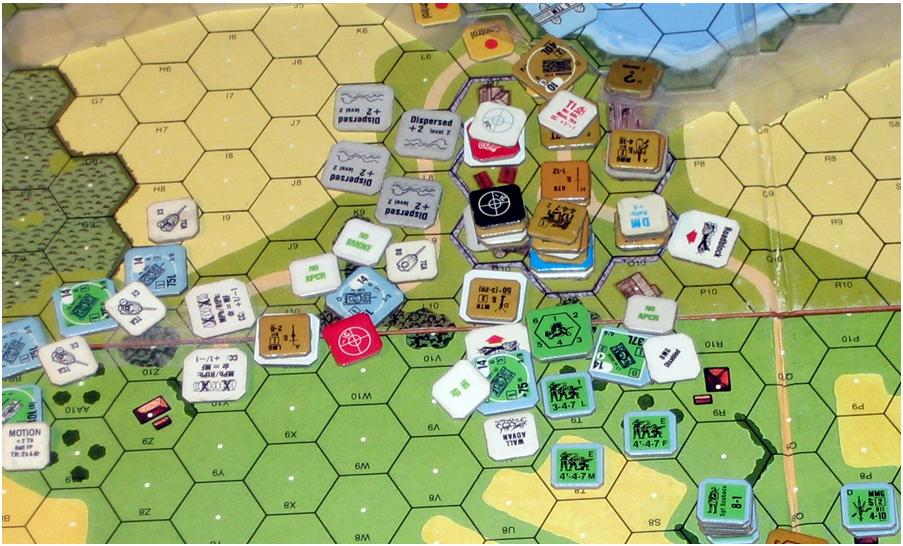
Meanwhile back on the right at the other pontoon bridge, there was more exciting action. The Stuart hit the PzIV and shocked it, and now things were looking very grim indeed for the Axis tankers. The Valentine started up and trundled over to finish off the weaker LTvz38. They popped open the hatch to increase visibility and get a better shot, and then the nearby Hungarian infantry opened fire with small arms, stunning the crew a second time. A second stun is a Recall, which was huge. Now there was some hope still left on this flank. In defensive fire, the LTvz38 immobilized the Stuart, but the Stuart crew stuck to their guns and did not bail out.
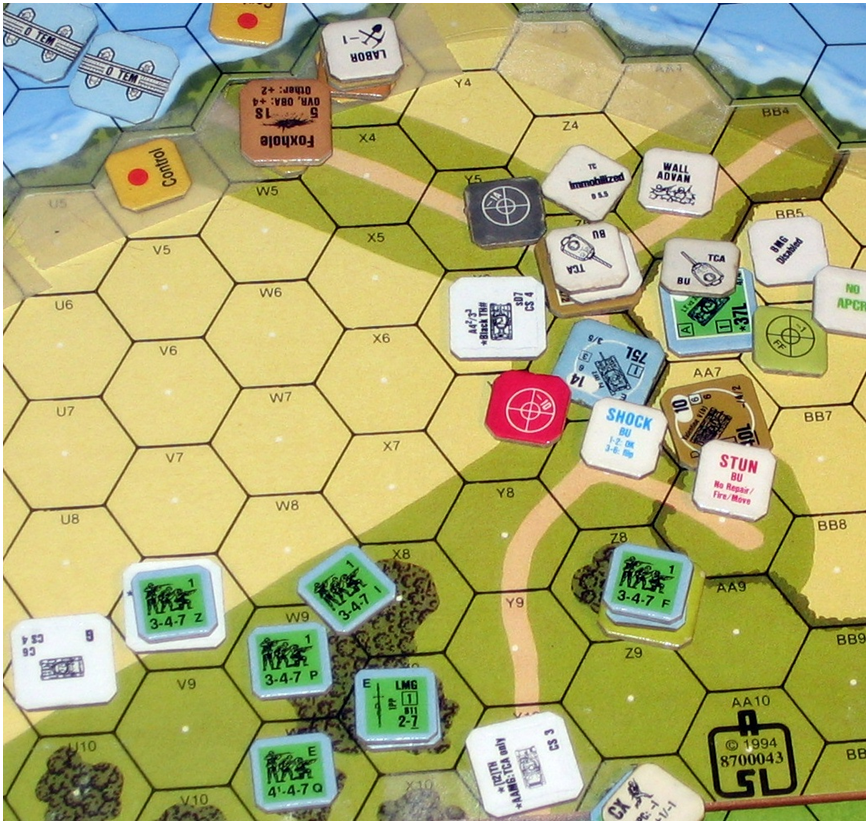
Turn 5 opened with the PzIV coming back from its shock result, and putting the kibosh to the Stuart once and for all in prep fire. The tank battle finally won on this side, the infantry moved forward across the grain toward the final objective, the area around the pontoon bridge. But here I got sloppy and made a mistake. It’s easy to forget a tank under Recall, but it can still fire. I started the LTvz38 up in the movement phase and it was promptly dispatched by the wounded Valentine. Then in defensive fire, the Valentine used intensive fire to kill the PzIV. That was ugly, and possibly preventable. I should have had the LTvz38 shoot the Valentine in prep fire, and if that failed (which was likely, given the tough hide of the Valentine), I should have had the PzIV take an intensive fire shot. This was a costly mistake, but at least there were no Russian tanks left on this flank that could do much more, since the Valentine had to leave the map to satisfy its Recall status in the next movement phase.
The right flank on turn 5:
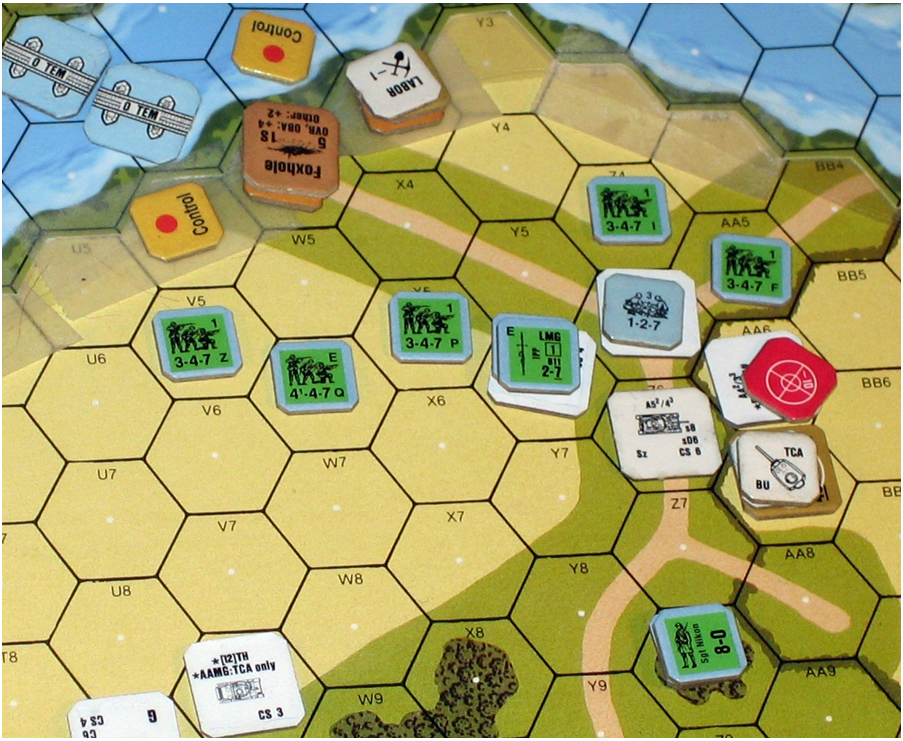
Back on the left, the artillery crew started pushing their gun to the other side of the compound since the Hungarian armor seemed to mostly be coming from that direction. But now was the time to fully assault the compound. A LTvz38 went into bypass near the roadblock and took a bounding fire shot with its coaxial machine gun at the gun crew in the middle of the zone. It was only a 2+0 shot, but it managed to pin the crew. Being pinned meant that they could not pivot the gun nor use its rate of fire. Seizing the moment, the remaining tanks crashed over the compound walls. One drove right into the crew’s hex and hosed them down with machine guns for a 6+0 shot, breaking them. Then it proceeded to move right into the Valentine’s hex to distract it. The Valentine missed its shot, and now with target selection limits imposed by the enemy vehicle in its own location, it was done for. The rest of the Axis tanks swarmed and one of them managed to drill a hole into the Valentine. The Hungarian infantry pressed forward as well, and now as Russian units broke they had enemies in all directions and therefore many were eliminated for rout failures. A Russian conscript squad was captured in close combat, but they and their captors were soon gunned down in the street by the Russian medium machine gun. Still, the fat lady was starting to do her do-re-mis. What looked like such a formidable defense not long ago collapsed in a hurry under sheer weight of numbers and encirclement.
Left flank on turn 5:
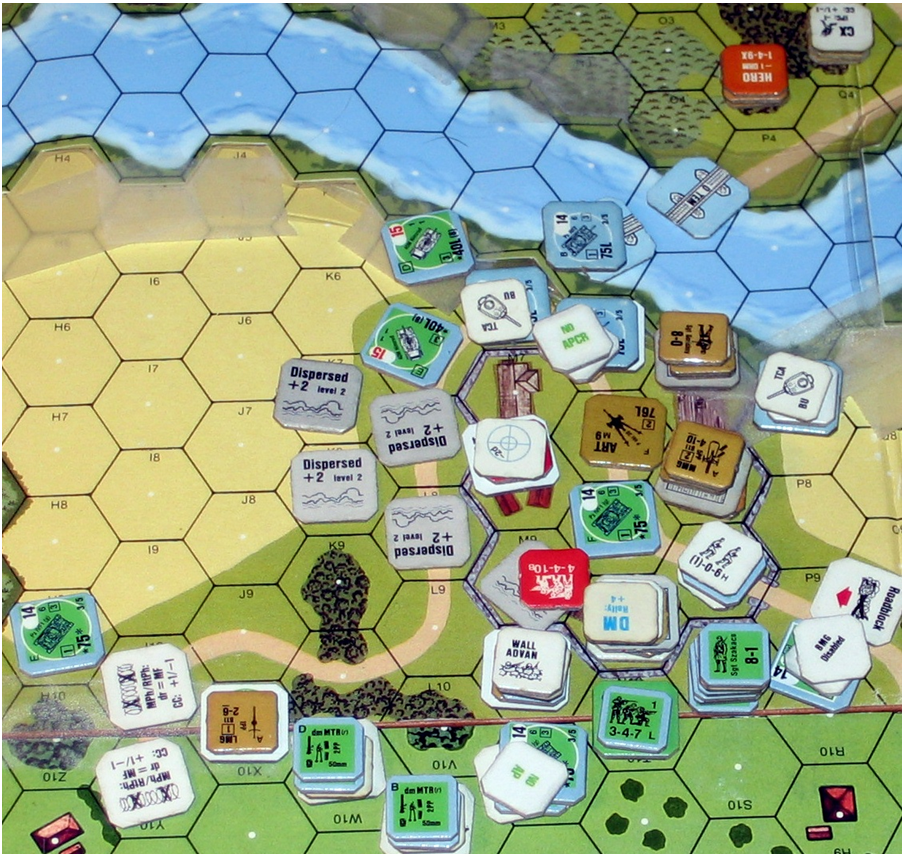
The Russian half of turn 5 saw a berserk squad charge a tank in the center of the compound and get machine gunned down, and the remaining Russians were doomed. The T-34 reinforcements arrived and pulled up on the opposite side of the river to engage the bevy of Hungarian tanks in and around the pontoon bridge. Both sides missed all their shots in this turn, but in the following turn’s pre fire the PzIVs destroyed the first two T-34s, at which point Brian threw in the towel.
The compound at game end:
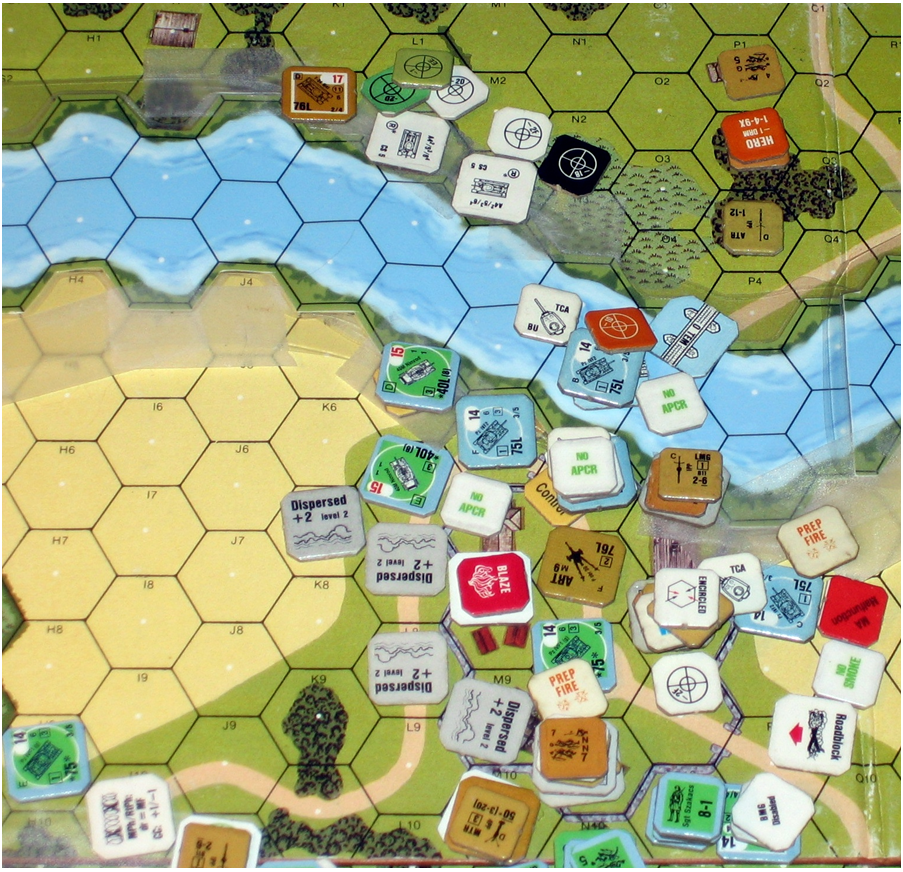
I really had a lot of fun playing this game. Brian is always a treat to play, and it was fun to dive into a new scenario from Armies of Oblivion. I hardly think either of us played a really tight game, and we made many mistakes. I foolishly assembled both medium machine guns in the little farmhouse on board 44 to support the attack into the central village, but the attack swept forward so fast that the machine guns couldn’t keep up. Their owners tried to lug them forward but they are heavy and the wire made movement more difficult. Then they got harassed by the Russian sniper for much of the game. But this scenario is intriguing since it presents so many options to both players. Hence the replay value is strong, and I’d certainly like to give it a whirl again. The defenders could use the wire and roadblocks to create a fortress at one of the bridges, or try to use them to seal off a flank, or use them to impede passage through the village as Brian did. There are numerous good spots to hide the gun. The attackers could pig pile into the central village like I did, or perhaps send a massive swarm down one flank or the other, or divide their forces and go down both flanks. I agree with Zeb’s thoughts that winning the armor superiority battle is the key. If one side can win it outright, it’s difficult to imagine them losing. But winning the tank battle is quite a trick. The matchups are not even, but all the tanks are dangerous in their own way. I think it’s too early to draw many conclusions about this scenario. I’d like to play it again, and experiment with different ideas for both attack and defense.
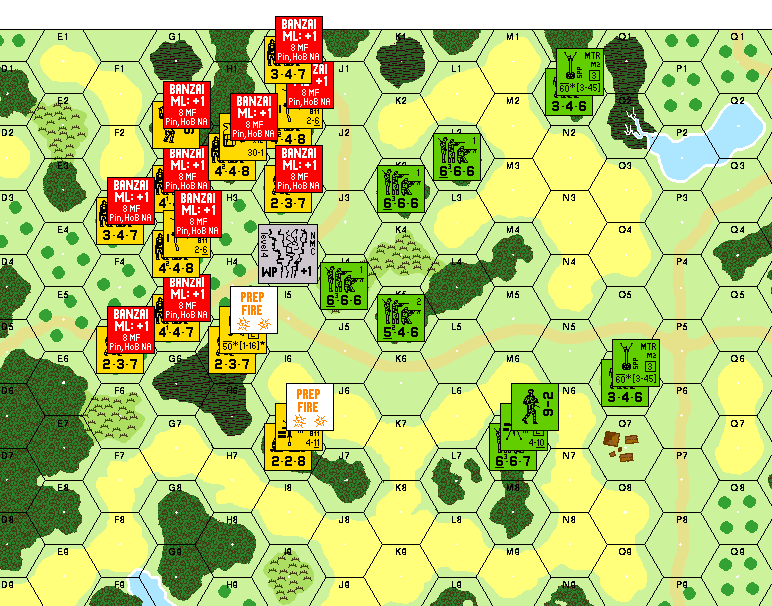
1 comment:
Great AAR, Matt. I agree, there are a lot of setup options here. I like to be a bit more spread out on D, otherwise once the main position falls it is curtains as we saw here. It looks like Brian didn't have much luck with his ATRs - if they're back in the Koresh Compound with the rest of the boys, they're likely to see only frontal facings - maybe as pickets off to one flank or in a secondary position. I liked the systematic attack - when you rushed things, you got your ears pinned back, but otherwise you timed it just right and had things well in hand by the time the T-34s showed up. Hope to see a similar report if you give it another go.
I mentioned this on the Forums, but I believe the U10/M10 Roadblock is illegal - I think they have to be across road hexsides.
Thanks again for the great report!
JR
Post a Comment